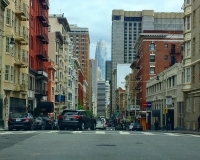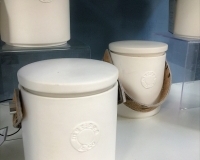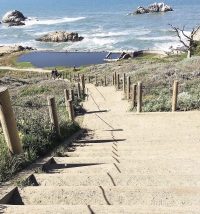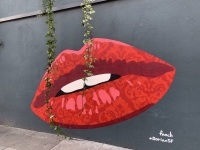JAPANESE TEA GARDEN
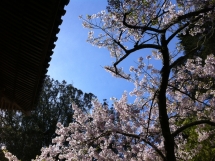
In the Golden Gate Park, San Francisco
All year long
The oldest Japanese-style garden in the US is a heaven of zen in San Francisco and has so much to offer!
Stroll around the lanterns and on the ponds, chase the dragon, find the minuscule turtle on the water basin, admire the mountains, climb onto the drum bridge, and finally treat yourself with a tea and fortune cookies before meditating on a bench or in front of the Buddha statue.
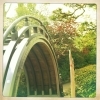
> This garden is a master piece
Landscaping a garden is regarded as the most accomplished form of art in the Japanese culture. It requires not only gardening skills but also patience and knowledge of buddhist philosophy.
In a zen garden, every stone, pond and plant has a reason to be and is carefully chosen and placed.
A Japanese garden is based on 4 aesthetic principles :
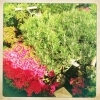 Miniaturization : in a very limited space, the garden represents the essence of nature in a concrete and an abstract way. Every season should reveal its beauty and diversity, with a right balance of yin-yang. In an arrangement of three stones , the tallest one represents heaven, the shortest one earth, and the medium one humanity (as a bridge between the two others).
Miniaturization : in a very limited space, the garden represents the essence of nature in a concrete and an abstract way. Every season should reveal its beauty and diversity, with a right balance of yin-yang. In an arrangement of three stones , the tallest one represents heaven, the shortest one earth, and the medium one humanity (as a bridge between the two others).
 Concealment : although you can have an overall view point of the garden because of its size, you can discover it properly as you're following the winding path, revealing you the details little by little. In this garden, you have to follow from tail to head the dragon hedge before you can tell it's a dragon.
Concealment : although you can have an overall view point of the garden because of its size, you can discover it properly as you're following the winding path, revealing you the details little by little. In this garden, you have to follow from tail to head the dragon hedge before you can tell it's a dragon.
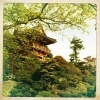 Extended scenery : Japanese gardens look larger than they really are as they include outside views on mountains or other trees ; in this case, the garden stands within another garden : the Golden Gate Park.
Extended scenery : Japanese gardens look larger than they really are as they include outside views on mountains or other trees ; in this case, the garden stands within another garden : the Golden Gate Park.
 Assymetry : the winding path make you stroll around stones, lanterns, plants. Even when crossing a pond, notice the stones you're walking on are never lined up.
Assymetry : the winding path make you stroll around stones, lanterns, plants. Even when crossing a pond, notice the stones you're walking on are never lined up.
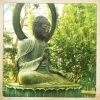
> This garden is a perfect spot for meditation
In fact, a Japanese garden is dedicated to meditation.
The yin-yang principle is represented whenever possible. Which is why the association of stone and water is omnipresent. Here are a few examples in this SF garden : cascade, symbolized by the space between the two rocks, waves in sand to represent water (both represented in the zen garden), water basin made out of stone, flat stones to cross ponds...
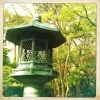 Buddhist cosmology is represented through symbols like stone lanterns. They represent the 5 elements (the base touching the ground is the earth, the next section is the water, the section containing the light is the fire, the last two upper sections represent air and spirit. That's the reason why they are so important and that you will find a few of them in this garden.
Buddhist cosmology is represented through symbols like stone lanterns. They represent the 5 elements (the base touching the ground is the earth, the next section is the water, the section containing the light is the fire, the last two upper sections represent air and spirit. That's the reason why they are so important and that you will find a few of them in this garden.

The Tea House has a specific purpose in a Japanese garden. To keep you awake during long hours of meditation, tea houses have been introduced in those gardens. Before the tea ceremony, you are supposed to wash your hands and mouth in a water basin. The one located in the Golden Gate Park is next to the Gift Shop. It's a carved stone in the shape of a boat that was found in a villa destroyed during WWII near Tokyo. A tiny turtle, symbol of luck, is carved in the basin.

> This garden is a testimony of San Francisco history
This garden originated in 1894 with the midwinterInternational Exposition for which a Japanese village was constructed. People involved in this project were M.H. De Young (exposition's director), George Turner Marsh (importer of Japanese fine art), John McLaren (GGP's intendant) and Makoto Hagirawa (local Japanese garden landscaper).
Once the exposition over, some features remained such as : the temple belfry gate (now south gate), the Two Story House (now Gift Shop), the Drum Bridge (featured in the movie « Memoirs of a Geisha), some stone lanterns... Hagirawa spent the next thirty years maintaining, improving and expanding the garden. He and his descendants lived there until the family was evicted and relocated during WWII. Sadly, anti-Japanese post WWII protests led to the destruction of some important features and the garden was renamed Chinese or Oriental Garden. In 1952, the name of the Japanese Tea Garden was officially reinstated and since then, efforts have been made to restaure the original spirit of the garden through landscaping and donations (stone lanterns, a Buddha statue, water basin, dry zen garden, cherry trees...). Before you leave, take a look at the stone enveloppend by a sculpture commemorating Makoto Hagiwara's passion and dedication...
> Practical information and tips
Japanese Tea Garden
75 Hagiwara Tea Garden Drive, Golden Gate Park, SF
Open daily from 9 am to 6 pm (summer) and from 9 am to 4.45 pm (winter)
Entrance Fee $0 - $7 upon day and age
For more information, click on their website
Tips :
- Free on Mondays, Wednesdays and Fridays if entered by 10 am
- Free 45 minutes guided tours organized by San Francisco City Guides
More information, click on their website
Good to know :
Tea ceremonies are organized on Wednesdays and Fridays in the morning, by apointement only, for $25 / person for age 13+. It's the authentic tea ceremony and the hostesses have been trained to serve the tea according to the custom. It has been recommended to us by an American-Japanese
For more details, click on this link, and call 415.752.1171 to make a reservation
 Fun fact:
Fun fact:
Japanese-Americans claim to have invented the famous Fortune Cookie in San Francisco, now produced in Chinatown. Makoto Hagiwara's chef would have brought the recipe from Japan and customized the biscuit with a fortune message for the San Franciscan Tea House. During WWII, Chinese bakers maintained the tradition which is now known as a Chinese custom. In any case, this is for sure an original biscuit made in San Francisco!
Agenda
-
Movie releases, Festivals & DVDs
-
Theatre plays, Ballet, Opera
-
Jazz, Rock, Pop, Symphonic & Co
-
Museums and Art Galleries
-
For them... with them...
-
Games and sports events
-
If you have some spare time...





